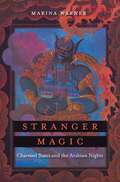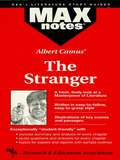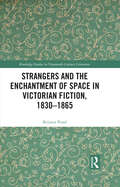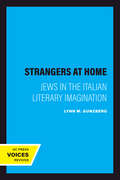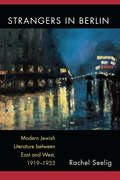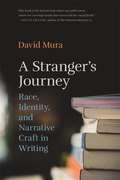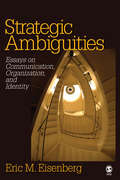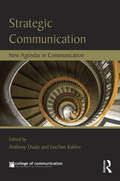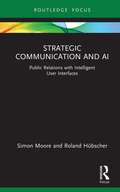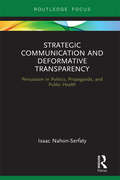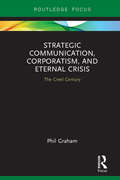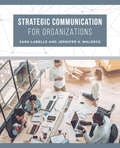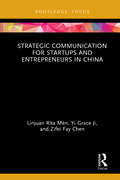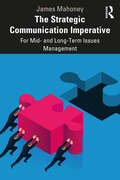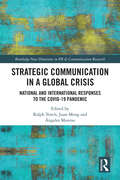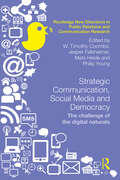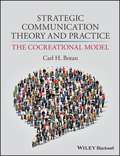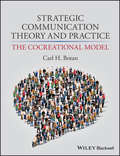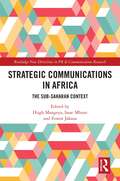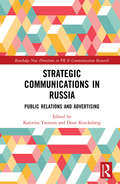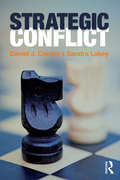- Table View
- List View
Stranger Magic: Charmed States and the Arabian Nights
by Marina WarnerOur foremost theorist of myth, fairytales, and folktales explores the magical realm of the imagination where carpets fly, objects speak, dreams reveal hidden truths, and genies grant prophetic wishes. Stranger Magic examines the wondrous tales of the Arabian Nights, their profound impact on the West, and the progressive exoticization of magic since the eighteenth century, when the first European translations appeared. The Nights seized European readers’ imaginations during the siècle des Lumières, inspiring imitations, spoofs, turqueries, extravaganzas, pantomimes, and mauresque tastes in dress and furniture. Writers from Voltaire to Goethe to Borges, filmmakers from Raoul Walsh on, and countless authors of children’s books have adapted its stories. What gives these tales their enduring power to bring pleasure to readers and audiences? Their appeal, Marina Warner suggests, lies in how the stories’ magic stimulates the creative activity of the imagination. Their popularity during the Enlightenment was no accident: dreams, projections, and fantasies are essential to making the leap beyond the frontiers of accepted knowledge into new scientific and literary spheres. The magical tradition, so long disavowed by Western rationality, underlies modernity’s most characteristic developments, including the charmed states of brand-name luxury goods, paper money, and psychoanalytic dream interpretation. In Warner’s hands, the Nights reveal the underappreciated cultural exchanges between East and West, Islam and Christianity, and cast light on the magical underpinnings of contemporary experience, where mythical principles, as distinct from religious belief, enjoy growing acceptance. These tales meet the need for enchantment, in the safe guise of oriental costume.
The Stranger (MAXNotes Literature Study Guides)
by Kevin KellyREA's MAXnotes for Albert Camus' The Stranger MAXnotes offer a fresh look at masterpieces of literature, presented in a lively and interesting fashion. Written by literary experts who currently teach the subject, MAXnotes will enhance your understanding and enjoyment of the work. MAXnotes are designed to stimulate independent thought about the literary work by raising various issues and thought-provoking ideas and questions. MAXnotes cover the essentials of what one should know about each work, including an overall summary, character lists, an explanation and discussion of the plot, the work's historical context, illustrations to convey the mood of the work, and a biography of the author. Each section of the work is individually summarized and analyzed, and has study questions and answers.
Strangers and the Enchantment of Space in Victorian Fiction, 1830–1865 (Routledge Studies in Nineteenth Century Literature)
by Kristen PondTracing the origins of how we think about strangers to the Victorian period, Strangers and the Enchantment of Space in Victorian Fiction, 1830-1865 explores the vital role strangers had in shaping social relations during the cultural transformations of the industrial revolution, transportation technologies, and globalization. While studies of nineteenth-century Britain tend to trace the rise of an aloof cosmopolitanism and distancing narrative strategies, this volume calls attention to the personalizing impulse in nineteenth-century literary form, investigating the deeply personal reflections on individual and national identities. In her book, Dr. Pond leads the reader through homes of the urban poor, wandering the Great Exhibition in the Crystal Palace, loitering in suburban neighborhoods, riding the railway, and touring a country estate. Readers will experience how the ordinary can be enchanting, and how the mundane can be unexpected, discovering a new way of thinking about strangers and their influence on our lives. Through an examination of the short and long fictional forms of Martineau, Dickens, Brontë, Gaskell, and Braddon, this study locates the figure of the stranger as a powerful topos in the story Victorian literature and the ethics of social relations. This book will be ideal for those seeking to understand the dynamics of the stranger in Victorian fiction as a figure for understanding the changing dynamics of social relations in England in the early nineteenth century.
Strangers at Home: Jews in the Italian Literary Imagination
by Lynn M. GunzbergUsing popular literature as a window on Italian society and its values, Lynn Gunzberg explores the representation of Jews in novels and poetry written by non-Jews from the beginning of the Risorgimento in the early 1800s to the enactment of the Fascist racial laws in 1938. She shows how the literature of that period contradicts the popular belief that anti-Semitism simply did not exist in Italy until late in the Fascist period.
The Strangers' House: Writing Northern Ireland
by Alexander PootsA penetrating study and celebration of Northern Irish literature—telling the region&’s story through the extraordinary novels and poetry produced by decades of conflict. Northern Ireland is one hundred years old. Northern Ireland does not exist. Both of these statements are true. It just depends who you ask. How do you write about a place like this? THE STRANGERS' HOUSE asks this question of the region&’s greatest writers, living and dead. What have they made of Northern Ireland – and what has Northern Ireland made of them? Northern Ireland is roughly the same size as the State of Connecticut, yet has produced an extraordinary number of celebrated poets and novelists. Louis MacNeice, too clever to be happy, formed by his childhood on the shores of Belfast Lough; son of a Protestant clergyman &“banned for ever from the candles of the Irish poor&”. C. S. Lewis, who discovered Narnia in the rolling drumlins and black rock of County Down. Anna Burns, chronicler of North Belfast and winner of the Booker Prize. And Seamus Heaney, the man of wry precision, the poet with the gift of surprise. As well as household names, Poots also examines writers who may be less familiar to an American readership. These include the dark and bawdy novels of Ian Cochrane, a half-blind writer obsessed with Columbo, and Forrest Reid, a man who saw Arcadia in the Irish countryside, and who was, perhaps, the North&’s first queer author. Reading the work of these writers together produces a testament to over one hundred years of literary endeavor and human struggle. THE STRANGERS' HOUSE is the story of how men and women have written about a home divided, and used their work to move, in the words of Seamus Heaney, &“like a double agent among the big concepts.&”
Strangers in Berlin: Modern Jewish Literature between East and West, 1919–1933
by Rachel Elana SeeligBerlin in the 1920s was a cosmopolitan hub where for a brief, vibrant moment German-Jewish writers crossed paths with Hebrew and Yiddish migrant writers. Working against the prevailing tendency to view German and East European Jewish cultures as separate fields of study, Strangers in Berlin is the first book to present Jewish literature in the Weimar Republic as the product of the dynamic encounter between East and West. Whether they were native to Germany or sojourners from abroad, Jewish writers responded to their exclusion from rising nationalist movements by cultivating their own images of homeland in verse, and they did so in three languages: German, Hebrew, and Yiddish. Author Rachel Seelig portrays Berlin during the Weimar Republic as a "threshold" between exile and homeland in which national and artistic commitments were reexamined, reclaimed, and rebuilt. In the pulsating yet precarious capital of Germany's first fledgling democracy, the collision of East and West engendered a broad spectrum of poetic styles and Jewish national identities.
Strangers in Blood
by Jean E. FeerickStrangers in Blood explores, in a range of early modern literature, the association between migration to foreign lands and the moral and physical degeneration of individuals. Arguing that, in early modern discourse, the concept of race was primarily linked with notions of bloodline, lineage, and genealogy rather than with skin colour and ethnicity, Jean E. Feerick establishes that the characterization of settler communities as subject to degenerative decline constituted a massive challenge to the fixed system of blood that had hitherto underpinned the English social hierarchy.Considering contexts as diverse as Ireland, Virginia, and the West Indies, Strangers in Blood tracks the widespread cultural concern that moving out of England would adversely affect the temper and complexion of the displaced individual, changes that could be fought only through willed acts of self-discipline. In emphasizing the decline of blood as found at the centre of colonial narratives, Feerick illustrates the unwitting disassembling of one racial system and the creation of another.
Strangers in the Archive: Literary Evidence and London’s East End (Victorian Literature and Culture Series)
by Heidi KaufmanTraditionally the scene of some of London’s poorest, most crime-ridden neighborhoods, the East End of London has long been misunderstood as abject and deviant. As a landing place for migrants and newcomers, however, it has also been memorably and colorfully represented in the literature of Victorian authors such as Charles Dickens and Oscar Wilde. In Strangers in the Archive, Heidi Kaufman applies the resources of archives both material and digital to move beyond icon and stereotype to reveal a deeper understanding of East End literature and culture in the Victorian age.Kaufman uncovers this engaging new perspective on the East End through Maria Polack’s Fiction without Romance (1830), the first novel to be published by an English Jew, and through records of Polack’s vibrant community. Although scholars of nineteenth-century London and readers of East End fictions persist in privileging sensational narratives of Jack the Ripper and the infamous "Fagin the Jew" as signs of universal depravity among East End minority ethnic and racial groups, Strangers in the Archive considers how archival materials are uniquely capable of redressing cultural silences and marginalized perspectives as well as reshaping conceptions of the global significance of literary and print culture in nineteenth-century London.Many of this book’s subjects—including digital editions of rare books and manuscript diaries, multimedia maps, and other related East End print records—can be viewed online at the Lyon Archive and the Polack Archive.
A Stranger's Journey: Race, Identity, and Narrative Craft in Writing
by David MuraIn this book, the author poses two central questions. The first involves identity: How is writing an exploration of who one is and one’s place in the world? The author examines how the myriad identities in our changing contemporary canon have led to new challenges regarding both craft and pedagogy. Here, like Toni Morrison’s Playing in the Dark or Jeff Chang’s Who We Be, A Stranger’s Journey breaks new ground in our understanding of the relationship between the issues of race, literature, and culture. The book’s second central question involves structure: How does one tell a story? The author provides clear, insightful narrative tools that any writer may use, taking in techniques from fiction, screenplays, playwriting, and myth. Through this process, he candidly explores the newly evolved aesthetic principles of memoir and how questions of identity occupy a central place in contemporary memoir.
Strategic Ambiguities: Essays on Communication, Organization, and Identity
by Eric M. Eisenberg"Eisenberg′s book is refreshing, in addition to its theoretical merits, for the presence of a distinctive human voice, unafraid to express passion, anger and hope. Readers will benefit enormously from the substance of his book, but also from its form."—HUMAN RELATIONSIn Strategic Ambiguities: Essays on Communication, Organization, and Identity, Eric M. Eisenberg, an internationally recognized leader in the theory and practice of organizational communication, collects and reflects upon more than two decades of his writing. Strategic Ambiguities is a provocative journey through the development of a new aesthetics of communication that rejects fundamentalisms and embraces a contingent, life-affirming worldview. Strategic Ambiguities: Explores the role of language and communication in the construction of social structures and personal identities. Provides a useful intellectual and historical context for students through framing chapters and head notes developed especially for this volume.Chronicles the historical development of an important argument about communicating and organizing through the sustained focus on a single theorist.Intended Audience:This text is designed for advanced undergraduate and graduate courses such as Organizational Communication, Communication Theory, and Organizational Behavior in the fields of Communication, Business & Management, and Educational Leadership."This collection of essays is insightful, thought-provoking, and forward-looking. Eric Eisenberg takes on challenging positions, writes in a cogent and accessible manner, and always stimulates new scholarship. This work will be an important teaching tool, not just for the innovative content of the writing, but also for the historical narrative of organizational communication embedded in it." —Steve May, University of North Carolina at Chapel Hill"Lay audiences will find the text rich with evocative narratives even as the theoretical moves will engage students and teacher-scholars. This edited compilation is likely to serve as a springboard for future inquiry and an invaluable resource for teaching and learning in undergraduate and graduate communication courses." —THE REVIEW OF COMMUNICATION
Strategic Communication: New Agendas in Communication (New Agendas in Communication Series)
by Anthony Dudo LeeAnn KahlorThe focus of this book is Strategic Communication. Communication can be defined as strategic if its development and/or dissemination is driven by an expected outcome. These outcomes can be attitudinal, behavioral, persuasive or knowledge-related; they can lead to change or engagement, or they can miss their mark entirely. In looking at strategic communication, one is not limited to a specific context or discipline. Many of the scholars in the volume are generating research that covers strategic communication in ways that are meaningful across fields. This volume collects the work and idea of scholars who cover the spectrum of strategic communication from source to message to audience to channel to effects. Strategic Communication offers news perspectives across contexts and is rooted firmly in the rich research traditions of persuasion and media effects. Spanning multiple disciplines and written to appeal to a large audience, this book will be found in the hands of researchers, graduate students, and students doing interdisciplinary coursework.
Strategic Communication and AI: Public Relations with Intelligent User Interfaces (Routledge Insights in Public Relations Research)
by Simon Moore Roland HübscherThis concise text provides an accessible introduction to Artificial Intelligence and Intelligent User Interfaces (IUIs) and how they are at the heart of a communication revolution for strategic communications and public relations. Intelligent user interfaces are where users and technology meet - via computers, phones, robots, public displays etc. They use AI and machine learning methods to control how those systems interact, exchange data, learn from and develop relations with users. The authors explore research and developments that are already changing human/machine engagement in a wide range of areas from consumer goods, healthcare and entertainment to community relations, crisis management and activism. They also explore the implications for public relations of how technologies developing hyper-personalized persuasion could be used to make choices for us, navigating the controversial space between influence, nudging, and controlling. This readable overview of the applications and implications of AI and IUIs will be welcomed by researchers, students and practitioners in all areas of strategic communication, public relations and communications studies.
Strategic Communication and Deformative Transparency: Persuasion in Politics, Propaganda, and Public Health (Routledge Focus on Communication Studies)
by Isaac Nahon-SerfatyThis book examines deformative transparency and its different manifestations in political communication, propaganda and public health. The objective is to present the theoretical foundations of deformative transparency, as grotesque and esperpentic transparency, and illustrate the validity of such approach to understand the strategic and ethical implications of the proactive disclosure of the "shocking", "ugly" or "outside the norm". Four areas are discussed: political communication with particular focus on populist politicians as the deceased Venezuelan president Hugo Chávez, the campaign and presidency of Donald Trump, and the tenure in office of the mayor of Toronto, Rob Ford; propaganda strategies of Islamist terrorist organizations such as the Islamic State’s escalation of the visually horrific; and public health campaigns that use "disturbing images" to promote public awareness and eventually influence behavioural change. This study on the transparently grotesque is part of a research program about the economy of emotions in public communication.
Strategic Communication, Corporatism, and Eternal Crisis: The Creel Century
by Phil GrahamThis book traces a century of militarised communication that began in the United States in April, 1917, with the institution of the Committee on Public Information (CPI), headed by George Creel and tasked with persuading a divided US public to enter World War I. Creel achieved an historic feat of communication: a nationalising mass mediation event well before any instantaneous mass media technologies were available. The CPI’s techniques and strategies have underpinned marketing, public relations, and public diplomacy practices ever since. The book argues that the CPI’s influence extends unbroken into the present day, as it provided the communicative and attitudinal bases for a new form of political economy, a form of corporatism, that would come to its fullest flower in the “globalisation” project of the mid-1990s.
Strategic Communication for Organizations
by Sara LaBelle Jennifer H. WaldeckStrategic Communication for Organizations elucidates the emerging research on strategic communication, particularly as it operates in a variety of organizational settings. This book, appropriate for both students and practitioners, emphasizes how theory and research from the field of communication studies can be used to support and advance organizations of all types across a variety of business sectors. Grounded in scholarship and organizational cases, this textbook: focuses on message designprovides introductory yet comprehensive coverage of how strategy and message design enable effective organizational and corporate communicationexplores how theory and research can be synthesized to inform modern communication-based campaignsStrategic Communication for Organizations will help readers discuss how to develop, implement, and evaluate messages that are consistent with an organization’s needs, mission, and vision, effectively reaching and influencing internal and external audiences.
Strategic Communication for Startups and Entrepreneurs in China (Routledge Insights in Public Relations Research)
by Linjuan Rita Men Yi Grace Ji Zifei Fay ChenThis book presents a comprehensive guide for public relations and strategic communication professionals and entrepreneurs to effectively manage the communication aspects of startups in the context of business in China. Drawing on interdisciplinary theories, current issues, and updated research evidence obtained from entrepreneurs and startup leaders in China, this concise volume provides research-based insights on the best practices for public relations and strategic communication in the unique context of startups. It addresses relationships with stakeholders, public relations practice, leadership communication, and how to leverage the power of social media in the entrepreneurial context. Strategic Communication for Startups and Entrepreneurs in China will be of great benefit to public relations and strategic communication scholars and practitioners, startup leaders and entrepreneurs interested in opportunities in China, and advanced students in public relations, business communication, and entrepreneurship.
The Strategic Communication Imperative: For Mid- and Long-Term Issues Management
by James MahoneyThis book proposes a model for directly aligning strategic communication with organisational business planning to enable effective management of mid- to long-term organisational issues. It argues that current conceptualisations of strategic communication need to be extended to locate it more precisely within definitions of strategy and as an essential element of mid- and long-term business planning. This approach re-positions strategic issues communication in a professional practice dimension that has a specific focus on issues that do not immediately impact on an organisation’s ability to achieve its day-to-day business goals. Full of contemporary examples from business, and including a thorough explanation of how the model can be applied in professional practice, the book will prove illuminating reading for scholars, students, and professionals alike.
Strategic Communication in a Global Crisis: National and International Responses to the COVID-19 Pandemic (Routledge New Directions in PR & Communication Research)
by Ralph Tench Juan Meng Ángeles MorenoThis edited volume makes a unique and timely contribution by exploring in depth the topic of strategic communication and COVID-19 from a global perspective. It’s widely agreed that effective and timely communication and leadership are crucial to the successful management of any pandemic. With the ongoing and possibly long-lasting impact COVID-19 has generated to many aspects of communication and multiple sectors of our societies, it is critical to explore the role of strategic communication in change management during the COVID-19 pandemic and beyond. Therefore, this book addresses such a need and is thoroughly grounded in rich empirical evidence gained through a global study of COVID-19 communication experiences and strategies. In the second half of 2020, a transnational team of senior researchers conducted research to investigate COVID-19 communications (COM-COVID-19) in different countries, representing Europe, Africa, Latin America, North America, South America, and Asia. The results presented in this book provide a compelling, current picture of the COVID-19 pandemic and strategic communication globally. Chapters individually explore the national and regional experiences and discuss relevant success and failures of pandemic communication and specific learning from the 2020/21 crises. By emphasizing the discussion on key communication channels, sources of information, facts and concerns as related to the COVID-19 pandemic, the editors call for actions to develop effective strategies within unique national contexts, which can shed light on global expectations on necessary public health responses and communication. This book is written for scholars, educators and professionals in communication, public relations, strategic communication and corporate communication. It is also appropriate to use this book as a supplementary text for advanced undergraduate and graduate courses on relevant courses.
Strategic Communication, Social Media and Democracy: The challenge of the digital naturals (Routledge New Directions in PR & Communication Research)
by W. Timothy Coombs, Jesper Falkheimer, Mats Heide and Philip YoungToday almost everyone in the developed world spends time online and anyone involved in strategic communication must think digitally. The magnitude of change may be up for debate but the trend is unstoppable, dramatically reconfiguring business models, organisational structures and even the practice of democracy. Strategic Communication, Social Media and Democracy provides a wholly new framework for understanding this reality, a reality that is transforming the way both practitioners and theoreticians navigate this fast-moving environment. Firmly rooted in empirical research, and resisting the lure of over-optimistic communication dreams, it explores both the potential that social media offers for changing the relationships between organisations and stakeholders, and critically analyses what has been achieved so far. This innovative text will be of great interest to researchers, educators and advanced students in strategic communications, public relations, corporate communication, new media, social media and communication management.
Strategic Communication Theory and Practice: The Cocreational Model
by Carl Botan<p>Communication is a core function of every human organization so when you work with communication you are working with the very core of the organization. Written for students, academics, and professionals, Strategic Communication Theory and Practice: The Cocreational Model argues for a single unified field of strategic communication based in the three large core subfields of public relations, marketing communication, and health communication, as well as strategic communicators working in many other subfields such as political communication, issues management, crisis communication, risk communication, environmental and science communication, social movements, counter terrorism communication, public diplomacy, public safety and disaster management, and others. Strategic Communication Theory and Practice is built around a cocreational model that shifts the focus from organizational needs and the messages crafted to achieve them, to a publics-centered view placing publics and their ability to cocreate new meanings squarely in the center of strategic communication theory and practice. The author—a noted expert in the field—outlines the theories, campaign strategies, common issues, and cutting edge challenges facing strategic communication, including the role of social media, ethics, and intercultural strategic communication. <p>As the author explains, the term "strategic communication" properly refers only to the planned campaigns that grow out of research and understanding what publics think and want. This vital resource answers the questions of whether, and how, strategic-level skills can be used across fields.</p>
Strategic Communication Theory and Practice: The Cocreational Model
by Carl H. BotanA guide to strategic communication that can be applied across a range of subfields at all three levels—grand strategic, strategic, and tactical communication Communication is a core function of every human organization so when you work with communication you are working with the very core of the organization. Written for students, academics, and professionals, Strategic Communication Theory and Practice: The Cocreational Model argues for a single unified field of strategic communication based in the three large core subfields of public relations, marketing communication, and health communication, as well as strategic communicators working in many other subfields such as political communication, issues management, crisis communication, risk communication, environmental and science communication, social movements, counter terrorism communication, public diplomacy, public safety and disaster management, and others. Strategic Communication Theory and Practice is built around a cocreational model that shifts the focus from organizational needs and the messages crafted to achieve them, to a publics-centered view placing publics and their ability to cocreate new meanings squarely in the center of strategic communication theory and practice. The author—a noted expert in the field—outlines the theories, campaign strategies, common issues, and cutting edge challenges facing strategic communication, including the role of social media, ethics, and intercultural strategic communication. As the author explains, the term "strategic communication" properly refers only to the planned campaigns that grow out of research and understanding what publics think and want. This vital resource answers the questions of whether, and how, strategic-level skills can be used across fields, as it: Explores the role of theory and the cocreational meta-theory in strategic communication Outlines ethical practices and problems in the field Includes information on basic campaign strategies Offers the most recent information on risk communication, preparedness and terrorism communication, and employment in strategic communication Redefines major concepts, such as publics, from a cocreational perspective
Strategic Communications in Africa: The Sub-Saharan Context (Routledge New Directions in PR & Communication Research)
by Hugh MangeyaStrategic communication is a pre-requisite for the achievement of organisational goals and an effective strategic communication plan is vital for organisational success. However, systems and models dominant in the west may not necessarily be best suited for the sub-Saharan Africa reality, where many organisations lack adequate financial resources to develop and implement an effective strategic communication plan. This book examines current practices in sub-Saharan Africa, as well as the challenges faced and the intersection with culture. The Editors package inspiring debates, experiences and insights relating to strategic communication in all types of institutions, including private and public sector organisations, governmental organisations and NGOs, political parties as well as social movements in the sub-Saharan context. It explores how culture is integral to the attainment of strategic communication goals, and diverse case studies across socio-economic contexts offer insights into the successes of organisations across Africa, including Zimbabwe, South Africa, Tanzania, Lesotho, Zambia, and Nigeria. This unique edited collection is a valuable resource for worldwide scholars, researchers and students of strategic communication and organisational studies, as well as related fields including public relations, advertising, political and health communication, and international studies.
Strategic Communications in Russia: Public Relations and Advertising (Routledge New Directions in PR & Communication Research)
by Tsetsura, Katerina / Kruckeberg, DeanThis book serves as a reader exploring the scholarly inquiry, professional education, and practice of Russian public relations and advertising in multiple contexts. It examines significant parts of what can be encompassed under the umbrella of strategic communications, including public relations and advertising, rather than investigating all areas of communication in Russia. Within the context of Russia’s history, culture, and ideology, the book begins by tracing the development of communication as a field, as a discipline, and as a social institution in Russia. It then samples current studies in Russian strategic communications, examining this professional specialization’s current state and likely future directions. The book’s authors are mostly Russians who are experts in their specializations. Chapters are predicated upon the premise that this is an exciting time of great opportunity for Russian strategic communications. However, in Russia, exploiting such opportunities for strategic communications scholarship, education, and professional practice presents challenges within the context of that nation’s cultural, historical, and ideological heritage that presently may be unique. The book concludes with a prognosis of the future of Russian strategic communications. The book is recommended reading for a worldwide audience of strategic communications scholars, educators, students, and practitioners. Such readers will find the book of interest and of unique value as the book will help them to better understand, appreciate, and respect Russian strategic communications, its genesis, and present state.
Strategic Conflict (Routledge Communication Series)
by Daniel J. Canary Sandra LakeyStrategic Conflict offers a research-based, accessible analysis of how people can manage conflict productively. Moving beyond the basics of conflict, it examines interpersonal situations in which conflict occurs and promotes strategic communicative responses based on the latest theoretical research. Daniel J. Canary and his colleagues add personal observations, media examples, and samples of actual interaction to provide concrete illustrations of the research findings. This comprehensive volume provides students with the tools to understand conflict in real-world contexts. ?
Strategic Facilitation of Complex Decision-Making
by Ariel Macaspac HernándezThis book provides theoretical and practical insights for effective decision making in situations that involve various types of conflict cleavages. Embedding historical analysis, negotiation analysis, political scientific analysis and game theoretical analysis in an integrated analytical framework allows a comprehensive perspective on various dilemmas and self-enforcing dynamics that inhibit decision making. The conceptualization of strategic facilitation highlights the value of leadership, chairmanship and the role of threshold states in facilitating decision making as the global climate change negotiations unfolds.
